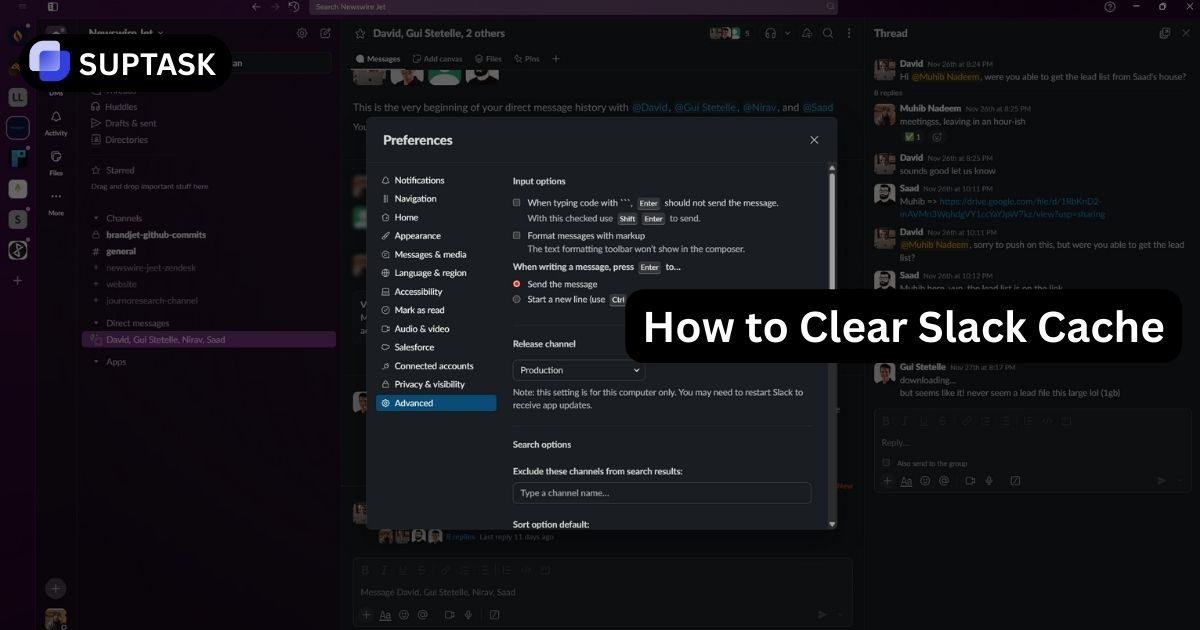Cross-collaboration is a concept in which teams from various departments unite to achieve common goals.
It emphasizes its essential role in fostering innovation and enhancing productivity, underscoring its significance in contemporary business practices.
Key Takeaways
- Cross-functional collaboration: Leverages diverse skills to achieve goals, boosting innovation, efficiency, and employee engagement.
- Benefits: Enhanced creativity, streamlined processes, improved problem-solving, and better customer experience.
- Best practices: Clear objectives, collaborative tools, and a culture fostering trust and knowledge sharing.
Understanding Cross Collaboration
.webp)
Cross-functional collaboration aims to achieve a common goal by uniting individuals from different departments.
But what is cross-functional collaboration exactly? It's a collaborative tactic essential in the current business climate, promoting innovation, efficiency, and flexibility through concerted cross-functional collaboration efforts that typically include working together across teams.
By breaking down silos and encouraging team cooperation while learning from other teams’ experiences, companies can create an environment that enhances productivity and competitiveness thanks to these collaboration efforts.
Definition of Cross Collaboration
Cross-functional collaboration is a strategic approach that leverages the unique strengths of various departments to work on cross-functional projects or initiatives.
It harnesses an organization's diverse skills and perspectives to achieve shared objectives.
This collaborative process typically involves team members from different areas working together to bring a project to fruition. Some benefits of cross-functional collaboration include:
- Increased innovation and creativity
- Improved problem-solving and decision-making
- Enhanced communication and knowledge sharing
- Increased efficiency and productivity
- Improved employee engagement and satisfaction
By fostering cross-functional collaboration, organizations can tap into the full potential of their employees and achieve tremendous success.
For example, a new product launch might involve a cross-functional team comprising members from the marketing, sales, and product development teams.
This integrated approach ensures the optimal utilization of each department’s expertise, resulting in a more thorough and successful outcome.
Importance in Today's Business World
In today’s business environment, just one team can't take on the full responsibility for a product or service.
Effective cross-functional collaboration is vital for aligning messages, understanding customer needs, and enhancing productivity.
Enhanced communication and alignment through such collaboration enable businesses to tackle problems more efficiently and cultivate a more integrated working atmosphere.
Providing an outstanding customer experience is deeply connected with adept cross-functional collaboration.
Seamless cooperation among different departments ensures a better grasp of customers' expectations, improving satisfaction rates and fostering stronger loyalty.
Critical Benefits of Cross-Collaboration
.webp)
Encouragement of cross-functional collaboration offers companies numerous advantages.
This approach combines varied skill sets and viewpoints, leading to more innovative and well-rounded resolutions.
Such interaction fosters increased creativity and innovation, bolsters employee engagement, and refines workflows, making the outcomes quite striking.
We will now examine these benefits in greater depth.
Enhanced Innovation and Creativity
Successful cross-team collaboration, often realized via cross-functional cooperation, can significantly increase innovation and creativity.
When teams combine their members' diverse perspectives and skills, they can cultivate innovative thought and produce revolutionary ideas that could be missed without this integration.
Merging these varied insights results in a more thorough and perceptive problem-solving process that enhances product development.
The exchange of expertise plays an essential role in achieving this success. Team members across different departments sharing their specialized knowledge create a powerful innovation dynamic.
Such collaborative efforts propel forward-thinking solutions and improve organizational agility and robustness through synergy.
Improved Employee Engagement
Cross-functional collaboration plays a vital role in boosting employee engagement. It nurtures team spirit and establishes a supportive atmosphere, instilling collective accountability and inclusion within the team members.
This increased sense of ownership often results in heightened motivation and dedication toward achieving the company’s objectives.
As team members from various departments collaborate, they accomplish several things:
- They hone their communication abilities
- Forge more robust interpersonal connections
- Foster enhanced trust and understanding among colleagues
- Augment teamwork capabilities alongside conflict management skills
- Elevate overall productivity of the team as well as job satisfaction
Through working across different sectors within an organization, employees engage in cross-functional collaboration that offers numerous benefits.
By bringing together diverse perspectives, this collaborative approach strengthens departmental relationships and enables individuals to achieve greater heights through improved problem-solving skills, stronger partnerships, and greater innovation potential.
In the end, this approach drives success for the entire business.
Streamlined Work Processes
Cross-functional collaboration optimizes work processes by leveraging the distinct strengths inherent in each department.
Using the best team collaboration tools helps in this strategy by eliminating organizational silos and establishing a unified source of information, improving synchronization, and minimizing overlapping efforts.
The result is an acceleration in resolving issues and optimization of workflow efficiency. Adopting automated workflows coupled with robust frameworks can elevate this efficiency.
It allows teams to delegate time-consuming tasks, assign well-defined roles, and shift their focus onto key priorities – thus diminishing protracted execution periods and excessive communication that doesn’t add value.
Such streamlining not only bolsters productivity but also significantly enhances output quality.
Improvement in Customer Experience
The ability of cross-functional collaboration to improve the customer experience is a significant benefit.
When departments align their communication and grasp customers’ requirements collectively, companies can offer consumers improved value, service, and contentment.
Adopting this comprehensive strategy guarantees consistency and focuses on the customer at every interaction point.
Cultivating a culture of shared ownership centered around the customer is encouraged through cross-functional collaboration. Collaborative efforts among various stakeholders enable them to:
- Recognize deficiencies, prospects, and hurdles within the customer journey
- Drive ongoing enhancement and inventive solutions
- Achieve elevated levels of satisfaction and devotion from customers.
Best Practices for Successful Cross-Collaboration
.webp)
Organizations aiming to achieve effective cross-functional collaboration must adopt top practices encouraging productive team interaction and clear communication.
This involves defining precise goals and responsibilities, leveraging collaboration tools, and fostering an environment that supports a collaborative ethos.
Establish Clear Objectives and Roles
To achieve effective cross-functional collaboration, it is imperative to:
- Establish precise objectives
- Allocate distinct roles and duties
- Confirm that all team members comprehend the aims and their specific tasks
- Improve efficiency and unity within the group
- Formulate a comprehensive strategy that corresponds with the overall strategic goals of the organization
Giving explicit responsibilities to individuals within the team, including those leading teams, helps circumvent confusion and overlapping opinions.
Instruments such as RACI charts can help maintain everyone’s awareness of their positions.
Consistent candid conversations, along with unequivocal strategizing, are essential in confirming comprehension of assignments among team members, who should feel assured about their respective contributions.
Utilize Collaborative Tools
Project management tools are a linchpin for project managers overseeing cross-functional teams. They aid in the organization and control of tasks.
Platforms like Suptask empower stakeholders to monitor duties while clarifying individual roles by tracking triage tickets and their evolution.
This ticketing system, which acts directly within Slack, supports seamless communication and simultaneous collaboration, simplifying project management and observing advancements.
Platforms like Helpjuice consolidate data into one accessible location to augment knowledge sharing among team members and diminish repetitive efforts. To further optimize team dynamics, companies can explore the best people management software to efficiently manage team roles and interactions.
Implementing training sessions on utilizing these resources can significantly enhance productivity and outcomes in cross-functional collaboration scenarios.
Promote a Collaborative Culture
Promoting a collaborative culture is critical to fostering a successful cross-functional team. Building trust and encouraging knowledge sharing are key components of this culture.
Starting with small tasks to help the team get acquainted before moving on to larger projects can cultivate trust and respect within the team.
Recognizing and rewarding collaborative efforts can further reinforce this culture. When team members have more ownership and accountability in a decentralized project management approach, it can also benefit cross-functional teams.
This approach allows for greater flexibility and collaboration across different functions. Observing team communication and their willingness to help can provide insights into the effectiveness of collaborative efforts.
Examples of Successful Cross-Collaboration
.webp)
Practical instances of effective cross-functional collaboration can yield valuable lessons and motivation.
Firms such as Google and Spotify have utilized teams composed of various functional experts to foster innovation, enhance operational effectiveness, and elevate their customers' experiences.
Google's utilization of cross-functional teams showcases the significant innovation and creativity that can arise from integrating various skills and viewpoints.
This strategy has allowed Google to create pioneering products and services, distinguishing them within the cutthroat technology sector.
Google cultivates an atmosphere conducive to collaboration by guaranteeing alignment among all team members—emphasizing unity in direction and consensus in understanding.
Such an environment promotes open exchanges of ideas and expertise among every team member.
Spotify
Spotify’s functional approach is grounded in a robust cross-collaboration strategy incorporating diverse team insights and expertise.
This fusion of perspectives catalyzes the rapid progression of product creation while enriching the user interface, maintaining both innovation and a strong focus on user needs throughout their products.
By drawing upon immediate reactions and contributions from different departments, Spotify has crafted an agile iteration process that allows for constant refinement of its services to align with consumer demands.
FAQ
What is cross-functional collaboration?
Combining individuals from different departments to collaborate on a project.
Why is cross-functional collaboration essential?
It enhances teamwork, communication, alignment, and productivity within a company.
What are the key benefits?
Boosts innovation, creativity, and engagement and streamlines work procedures.
Best practices for success?
Promote a collaborative culture, set clear objectives, and use collaborative tools.
Examples of success?
Google and Spotify use cross-functional teams to innovate and improve efficiency.













